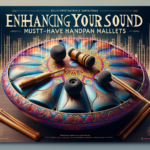The modern world is bustling, busy, and sometimes overwhelming. People are seeking solace in varied forms of meditation to gain peace and tranquility in their lives. One of the most compelling tools for such practices is music, particularly the unique and soothing sounds of handpan rhythms. Combining ancient musical traditions with contemporary craftsmanship, the handpan instrument offers therapeutic soundscapes that are ideal for enhancing meditation.
What is a Handpan?
The handpan is a relatively new musical instrument, having been developed in the early 21st century. Often described as “sculptures of sound,” handpans are part of the idiophone class of instruments, meaning they create sound primarily through the vibration of their material without the need for strings, reeds, or external resonators. The traditional handpan is typically crafted from two convex steel sheets that are glued together, creating a hollow, resonant vessel. When struck, the surface of the handpan produces a rich, harmonic tone that can be both calming and hypnotic.
The Role of Music in Meditation
Music has been an integral part of spiritual practices across various cultures for millennia. It has the power to deepen meditation, improve concentration, and enhance the overall experience of mindfulness. Melodic, harmonic, and rhythmic elements of music can all serve as focal points in meditation, helping practitioners to anchor their thoughts and synchronize their breathing. The unique soundscapes created by the handpan serve these purposes exceptionally well, fostering a deep sense of calm and emotional release.
Calming Handpan Rhythms
Handpan rhythms can range from slow and steady to more complex and dynamic patterns. The instrument’s capability to produce multiple notes simultaneously enables musicians to create lush, overlapping soundscapes. The combination of melody and rhythm in handpan music can be both soothing and entrancing. This is particularly beneficial for meditation, as the immersive sound experience can help to quiet the mind and reduce stress.
Benefits of Handpan Music for Meditation
The calming effects of handpan music can enhance meditation in several profound ways:
- Reduces Stress and Anxiety: The gentle and resonant tones of the handpan can help to lower cortisol levels, bringing about a state of relaxation and reduced anxiety.
- Improves Focus and Concentration: The rhythmic and melodic patterns can serve as an anchor for the mind, helping to maintain focus during meditation sessions.
- Promotion of Emotional Healing: The harmonious and contemplative sounds of the handpan can trigger emotional release, facilitating a sense of healing and emotional balance.
- Enhances Intuitive and Creative Thinking: The unique soundscapes of the handpan can stimulate the brain’s creative centers, enhancing intuitive thinking and problem-solving abilities.
Choosing the Right Handpan Music for Meditation
When selecting handpan music for meditation, it is important to consider the tempo and complexity of the rhythms. Pieces with slower tempi and simpler rhythmic patterns are often more effective for inducing deep meditation. Many musicians create specific handpan compositions intended for meditation, often incorporating natural sounds or other meditative instruments like chimes and Tibetan singing bowls.
Where to Find Handpan Music
Handpan music has grown in popularity, and there are many resources available for finding high-quality recordings:
- Streaming Services: Platforms like Spotify, Apple Music, and YouTube offer a wide variety of handpan music tailored to meditation.
- Specialized Websites and Stores: Several websites specialize in handpan music, offering downloads, CDs, and even live performance recordings.
- Local Musicians and Events: Attending handpan performances or workshops can be a great way to experience this unique music and potentially acquire recordings directly from the artists.
Creating Your Own Handpan Music
For those who are musically inclined, creating your handpan rhythms can be incredibly rewarding and therapeutic. Many handpan makers offer instruments in different tunings, allowing you to choose a scale that resonates with you personally. Here are a few steps to get started:
- Acquire a Handpan: Select an instrument that suits your needs and budget.
- Learn Basic Techniques: There are many tutorials available online that can teach you the basics of handpan playing, including striking techniques and simple rhythms.
- Experiment with Sounds: Take time to explore your instrument, discovering the different sounds and tones it can produce. This process will help you to develop your unique style.
- Compose Your Music: Start by creating simple, repetitive patterns and gradually build upon them. Focus on creating a coherent and calming soundscape that suits meditation.
Incorporating Handpan Music into Your Daily Routine
Integrating handpan music into your daily life can help to maintain a sense of serenity and mindfulness. Here are a few suggestions for incorporating this instrument into your routine:
- Morning Meditation: Start your day with a brief meditation session accompanied by handpan music to promote a calm and focused mindset.
- Yoga Practice: Use handpan music to enhance your yoga practice, fostering a deeper connection between mind, body, and breath.
- Evening Relaxation: Wind down in the evening with a few minutes of listening to handpan music, helping to ease the transition to a restful night’s sleep.
Conclusion
The serene and mystical sounds of the handpan make it an ideal accompaniment for meditation. Whether you are listening to recordings or playing the instrument yourself, the handpan’s unique sonic qualities can help to deepen your meditative practice, reduce stress, and enhance your overall well-being. By incorporating handpan rhythms into your daily routine, you can cultivate a lasting sense of inner peace and tranquility.
FAQs
1. What makes handpan music so effective for meditation?
Handpan music is effective for meditation due to its harmonic richness, calming tonal qualities, and rhythmic consistency. These elements help to anchor the mind, reduce stress, and facilitate a deeper meditative state.
2. Can anyone learn to play the handpan?
Yes, anyone with an interest in music can learn to play the handpan. While it may take time to master, basic playing techniques can be acquired relatively easily through online tutorials, workshops, and practice.
3. Where can I purchase a handpan?
Handpans can be purchased from specialized retailers, both online and in physical stores. Many handpan makers also sell their instruments directly through their websites. It’s important to research and choose a reputable maker to ensure the quality of the instrument.
4. Are there specific handpan rhythms that are best for meditation?
Generally, slower and simpler handpan rhythms are most effective for meditation, as they provide a calming and consistent soundscape. However, the best rhythm ultimately depends on your personal preference and how it affects your ability to meditate.
5. Can handpan music be combined with other forms of meditation music?
Absolutely! Handpan music blends well with various forms of meditation music, including natural sounds, ambient tracks, and other meditative instruments like singing bowls and chimes. Combining these can create a richer and more immersive meditation experience.





